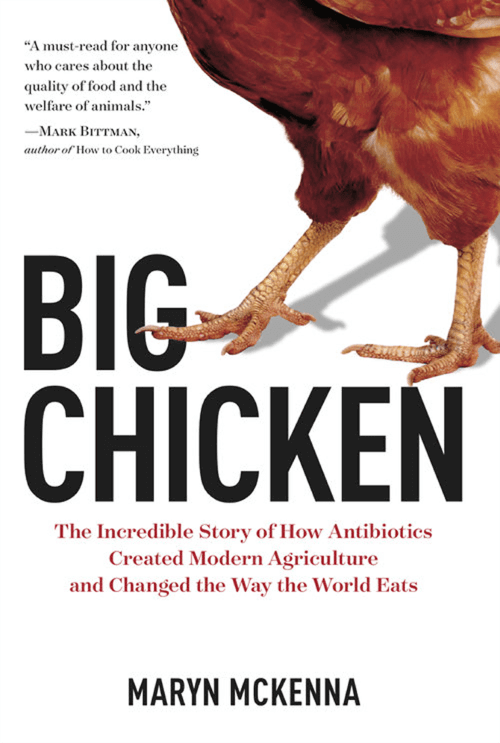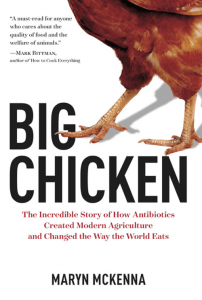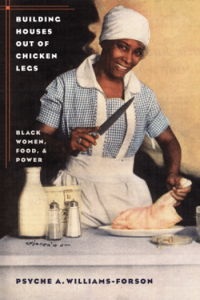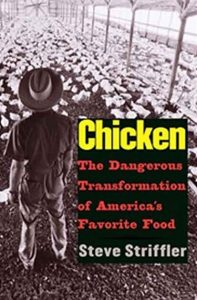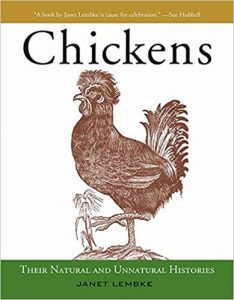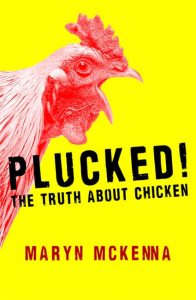by Maryn McKenna
From the publisher: Chicken is the world’s most popular meat, but its path to our plates winds through a dark and fascinating history. BIG CHICKEN: The Incredible Story of How Antibiotics Created Modern Agriculture and Changed the Way the World Eats explores the “backyard bird’s” meteoric rise from local delicacy to global commodity, and how it paved the way for a stunning transformation of farming worldwide.
Drawing on more than 100 interviews in the United States and Europe with farmers, lawyers, historians, microbiologists, politicians and chefs — and more than 1,000 pieces of research, many of them lost for decades until she uncovered them — McKenna pieces together the parallel, intertwined stories of the achievement of “growth promoter” antibiotics and the rise of the modern poultry industry. In a tour de force of scientific and cultural history, McKenna finds the connections between flavor and nutrition, genetics and history, labor and the role of women, and pollution and politics. Reaching back to the earliest days of the antibiotic era, she traces the unintended consequences of the post-World War II drive to feed the world inexpensively by producing meat as quickly as possible — and how those good intentions created a worldwide epidemic of drug-resistant infections that have defeated almost every antibiotic we have.
Among McKenna’s findings:
- Across much of the planet, the majority of meat animals receive antibiotics on most days of their lives, over 63,000 tons per year.
- Globally, animals receive at least twice as many antibiotics as people do — four times as many in the United States — and most of those agricultural doses go to animals that are not sick.
- That routine agricultural use of antibiotics dates back to the 1940s, to the earliest days of the antibiotic era — and right from the start, prescient, unheeded scientists warned that disaster would follow.
- The use of antibiotics has made chicken so cheap it is the most popular meat in America – and the meat most likely to transmit food-borne illnesses and antibiotic resistance, which the United Nations calls “the greatest and most urgent global risk.”
McKenna is an intrepid researcher and an expert interpreter of science; she uncovers the true origin of the chicken nugget, the tale of the “Chicken of Tomorrow” contest, and an astounding episode in the 1960s in which manufacturers added antibiotics to meat to extend its shelf life for months. McKenna also loves food. Describing the French street-market chicken that forever changed her experience of poultry, she writes: “Burnished and herbal, salty and slightly burnt, [the aroma] has so much heft that it feels physical, like an arm slid around your shoulders to urge you to move a little faster.”
McKenna writes with equal sympathy about activists for heritage animals who hope never to kill a chicken again and farmers proud of their costly investments growing chicken safely, consistently and more cheaply than ever before. She also identifies the earliest stirrings of an animal welfare movement that may change poultry production forever, and the surprising participation of big food companies that plan to carve out new markets by returning to old ways.
BIG CHICKEN is timely, explaining policy changes that occurred at the United Nations in 2016 and at the U.S. Food and Drug Administration just this year; and it is also urgent, warning of the vast farm antibiotic use that looms in the economies of the developing world. Bringing us on an extraordinary journey from the vast poultry farms of the United States to laboratories, kitchens and sidewalk markets around the world, McKenna reveals how economic, political and cultural forces converged to make America’s favorite meat a hidden danger—and how companies, activists, farmers and chefs are carving a path back to better, safer food.
Maryn McKenna is an award-winning journalist and the author of two critically acclaimed books, Superbug and Beating Back the Devil. She writes for the New York Times Magazine, The Atlantic, Newsweek, NPR, Wired, National Geographic, Scientific American, Slate, Nature and others, and is a senior fellow of the Schuster Institute for Investigative Journalism at Brandeis University and a journalism instructor at the University of Georgia.
National Geographic Books, 2017

